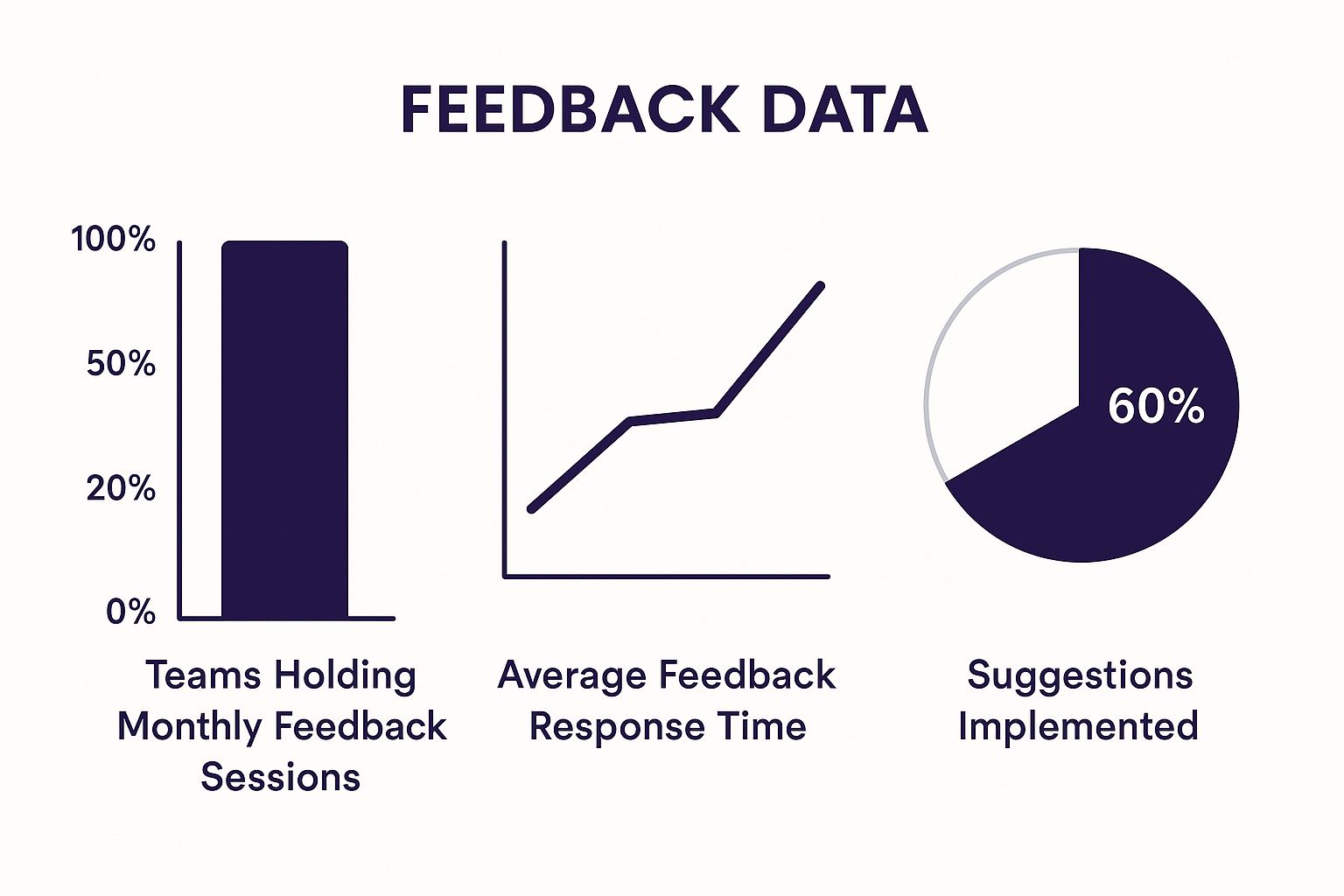Why Effective Internal Communication Transforms Organizations
When communication breaks down inside a company, it might seem like a small annoyance. But these small issues add up, hitting team spirit and even the company's bottom line hard. If information doesn't flow well, misunderstandings grow, projects slow down, and people just don't feel connected to their work. It's not just a feeling; poor communication causes real business problems.
Think about this: a huge 74% of employees report missing out on important company news because internal communication isn't up to scratch. Feeling out of the loop naturally makes people less engaged and hurts their performance. On the flip side, making a real effort to improve internal communication can pay off big time, boosting team productivity by 20-25%. Plus, knowing that 85% of employees feel more motivated when they get regular, clear updates from leadership shows just how much good communication matters. Find more detailed statistics here
The Tangible Benefits of Open Information Flow
Companies that manage to create smooth, open communication channels see results that go way beyond just keeping everyone informed. Building strong communication habits, like those seen at places like McKinsey, helps teams work together better and builds trust between different departments. When information moves freely, several clear benefits pop up:
- Reduced Employee Turnover: People who feel informed, connected, and listened to are happier and more likely to stay with the company.
- Faster Innovation Cycles: Open dialogue lets ideas and feedback flow more easily, speeding up how quickly problems get solved and new ideas take shape.
- Enhanced Trust: When leadership is open and communication is clear, it builds credibility and makes people feel safer, strengthening relationships.
- Improved Collaboration: Teams that understand what others are working on can break down barriers and work together more effectively on projects.
Putting effort into strategies to improve internal communication is really an investment in the overall health of your business. It's about more than just passing along information; it's about building a workplace where people feel connected, productive, and genuinely part of the company's goals.
Mapping Your Communication Landscape for Maximum Impact

Knowing that solid internal communication is important is the easy part. Actually achieving it starts with a clear look at where you stand right now. Before rolling out new plans or software, you need to map out your current communication setup. Understanding how information really moves—or gets stuck—is key to figuring out where efforts to improve internal communication will make the biggest difference.
Conducting a Communication Audit
Think of a communication audit like drawing a detailed map of how information travels within your company. It means looking closely at the channels you use, the messages you send, and the processes involved. This helps you spot the bottlenecks and snags holding things up.
An audit isn't just about what gets communicated; it’s about how, when, and by whom. Doing this thoroughly can uncover hidden roadblocks that prevent open and clear conversation.
Gathering Meaningful Employee Insights
Your team members know firsthand where communication breaks down. Asking for their feedback through well-designed surveys and group discussions can dig deeper than surface-level complaints. It helps uncover the real reasons for confusion or feeling out of the loop.
Getting honest opinions reveals the actual employee experience, which is vital for making smart changes. Asking the right questions helps identify:
- Which communication channels people prefer versus the ones they actually use.
- Where important information tends to get lost or twisted.
- How employees feel about transparency and communication from leadership.
Tracking Message Effectiveness
It's also crucial to follow the journey of important messages. Mapping how information spreads (or doesn't) across different departments and levels shows exactly where key updates stall or get altered.
Understanding these flow patterns allows you to make targeted fixes. This ensures messages reach the right people, intact and on schedule. This focused approach helps direct efforts to improve internal communication exactly where they're needed most.
To help structure this assessment, consider using a framework like the one below. It provides a systematic way to examine different facets of your internal communication.
Communication Assessment Framework A structured approach to evaluate your organization's current internal communication effectiveness
| Assessment Area | Key Questions | Measurement Methods | Common Issues |
|---|---|---|---|
| Channel Usage | Which channels get used most? Which do employees prefer? | Surveys, Analytics, Focus Groups | Over-reliance on ineffective channels |
| Message Clarity | Do employees understand key messages? Is information easy to find? | Comprehension surveys, Feedback sessions | Information overload, Jargon, Lack of context |
| Information Flow | Where does information get stuck? Are there silos between departments? | Network analysis, Process mapping | Bottlenecks, Lack of cross-functional info |
| Leadership Comm. | Is leadership communication seen as transparent and timely? | Pulse surveys, Interviews | Lack of visibility, Inconsistent messaging |
| Feedback Loops | Are there clear ways to give upward feedback? Is feedback acted upon? | Survey tools, Suggestion systems | Fear of speaking up, Feedback being ignored |
Using this framework helps pinpoint specific weaknesses in your communication strategy, from channel effectiveness to leadership messaging. This targeted diagnosis is the foundation for making impactful improvements.
Selecting Communication Channels That Actually Work

After mapping out how information flows in your company, the next step to improve internal communication is picking the right tools for the job. Just sending out information isn't effective. The communication channel you choose drastically affects whether your message gets seen, understood, and acted on. Choosing well means looking past old habits and figuring out what genuinely connects with your team.
Studies show surprising differences between the channels companies often use and the ones that actually get results. For example, email is almost everywhere (used by 92% of organizations) and generally seen as effective (89% rating), but it might not be the best for grabbing attention on critical updates. Meanwhile, things like all-employee live events have a remarkable 97% effectiveness rating, even though only 78% of companies use them.
This suggests that interactive, direct methods often work better than just sending information out. Knowing these details—like the fact that 36% of employees prefer meetings for internal updates—is crucial. On the other hand, some channels leaders might push, like podcasts (used by 20%), don't always connect well with staff. Matching your channels to effectiveness data and what employees prefer helps ensure your messages hit the mark. Explore communication statistics further
Matching the Channel to the Message and Audience
Different messages need different delivery methods, and not all employees respond the same way. Picking the right channel means thinking about a few things:
- Urgency and Complexity: Is it a quick update or a detailed policy needing discussion? Instant messages work for speed, but complex topics might need a meeting or a thorough document.
- Audience Location & Role: Are your employees at desks, working remotely, or out in the field? Mobile apps could be better for reaching field staff than an intranet site.
- Company Culture: Does your workplace prefer formal announcements or casual chats? Your channel choice should match the tone you want.
- Desired Action: Need quick feedback or people to join in? Interactive options like live Q&As or polls work better than a one-way email.
To help decide, let's compare some common channels based on how often they're used, how well they work, and what employees think.
Communication Channel Effectiveness Comparison Comparing usage rates, effectiveness, and employee preferences across different communication channels
| Communication Channel | Usage Rate | Effectiveness Rating | Employee Preference |
|---|---|---|---|
| 92% | 89% | Widely Accepted | |
| All-Employee Live Events | 78% | 97% | Highly Effective |
| Meetings | Varies | Varies | Preferred by 36% |
| Podcasts | 20% | Lower | Lower |
This comparison shows that high usage doesn't always mean highest effectiveness or preference. Channels like live events score very high on impact, while others like email are workhorses but might not be the best fit for every message.
Developing a Strategic Multi-Channel Approach
Depending on just one communication channel usually isn't enough. A strategic multi-channel approach can help reinforce important messages and reach people in the ways they prefer. But be careful – using too many platforms can backfire.
Bombarding employees with information everywhere leads to channel fatigue and information overload. This can actually weaken your efforts to improve internal communication. Be deliberate about your choices. Decide the main purpose for each channel (e.g., email for official news, chat for quick questions, intranet for storing resources).
As the table above shows, understanding channel effectiveness helps focus your strategy. Consistency across different platforms is also important. Make sure the core message stays the same, even if you adjust the format for each channel. This careful selection helps get critical information across without overwhelming your team.
Building a Culture Where Information Flows Freely
Picking the right ways to communicate is important, but they only work well if your company culture supports open sharing. Transparency isn't just a trendy word here; it's the bedrock for building trust across the organization. Creating this kind of open setting is a practical way to truly improve internal communication.
Leadership Sets the Tone for Transparency
Getting information to flow openly really starts with the leaders. When executives consistently share information—talking about successes and challenges—they signal that honesty is valued. This modeling of transparent behavior is vital for creating psychological safety, an atmosphere where employees feel comfortable sharing ideas, voicing worries, and having frank conversations without fear of punishment.
Practical Steps to Encourage Information Flow
Beyond what leaders do, certain practices can help break down information barriers and foster openness. Think about putting these ideas into action:
- Regularly Scheduled Town Halls: These shouldn't just be one-way presentations. Make them interactive, setting aside real time for unfiltered questions and answers with leadership.
- Accessible Digital Workspaces: Use platforms where everyone involved can easily find project updates, team objectives, and company news.
- Anonymous Feedback Channels: Provide options, like those available in modern employee engagement tools, where people can safely give feedback or report problems. This helps get input from those who might otherwise stay silent. Discover tools that facilitate feedback here
Navigating the Path to Openness
Making the switch to a more transparent culture isn't always easy. You might encounter initial awkwardness or pushback against the change. However, companies that successfully make this shift often see significant benefits, including much higher employee trust and a clear boost in innovation metrics, simply because more diverse ideas are being shared openly.
Finding the Right Balance
It's also key to understand that transparency doesn’t mean sharing every single detail with everyone. Good communication means finding a middle ground. Ensure people have access to the information they need while still protecting genuinely confidential company matters. Making these careful distinctions actually strengthens trust, rather than weakening it, when your goal is to improve internal communication.
Leveraging Technology to Transform Communication
Creating a culture where information flows freely is key, and technology plays a big part in making that happen. While most companies use basic digital tools, choosing and using the right tech can really strengthen internal communication. It helps people connect better and makes information easier to find for everyone. It's about picking systems that actually improve conversations, not just add more digital clutter.
Choosing the Right Tools for Connection
When picking technology, look past the shiny features. Find platforms that fit how your organization works and genuinely help people interact better. Think about these types of tools:
- Collaboration Platforms: Tools like Slack or Microsoft Teams can bring project talks and quick updates into one place, cutting down on email chains. Check how easy they are to use and if they connect well with other software you use.
- Intranet Systems: A good intranet acts like a central noticeboard for company news, resources, and files. Look for one that’s simple to navigate with a good search function so people can actually find what they need.
- Mobile Solutions: If you have staff working away from desks or out in the field, mobile communication apps are essential. Make sure they provide easy access and work smoothly no matter where your team members are.
The user experience (UX) is really important. If a tool is a pain to use, people won't use it. Cross-platform integration is also crucial – your tools should cooperate to prevent creating new places where information gets stuck.
Driving Adoption and Overcoming Challenges
Just rolling out new software isn't enough. You need to get people to actually use it. This means providing good training, explaining how the tool helps them personally, and having leaders actively use it themselves. But be careful about technology overload. Too many different tools can overwhelm employees and make them less productive, just like having too many ways to communicate.
Companies often run into issues like different comfort levels with technology, sometimes called generational adoption gaps. Offer specific help and training for those who need it. Security is another big piece; always check that any platform meets your company's rules for protecting data before you introduce it.
Measuring Technology's True Impact
To see if your communication tech is working, look beyond simple counts like logins or messages. Focus on the real return on investment (ROI) related to how well people are communicating. Are misunderstandings decreasing? Can people find information faster? Are different departments working together more effectively? Answering these questions gives a better sense of whether the technology is improving internal communication.
Tracking these kinds of results shows how technology helps meet bigger company goals. Platforms such as Happily.ai can provide data on how communication efforts might be affecting employee engagement.
Crafting Messages That Resonate With Every Employee

Having the right communication tools sets up the pathways for information, but what truly matters is the content flowing through them. A single message sent to everyone often fails to connect meaningfully with anyone. To genuinely improve internal communication, the information shared needs to feel relevant to each person receiving it.
Moving Beyond One-Size-Fits-All Communication
Think about those generic, company-wide emails – they often feel like junk mail, easy to ignore because they don't speak to your specific job or what you care about. Today's workforce is varied, with different needs and priorities, demanding a more considered approach than simple mass messaging.
This is where message personalization becomes essential. It means dividing your audience into groups based on certain characteristics to send them more suitable content. You could group employees by:
- Role (e.g., software developer vs. account manager)
- Department (e.g., Marketing vs. Operations)
- Location (e.g., main office vs. remote worker vs. field staff)
- Career Stage (e.g., recent hire vs. team lead)
Using data to guide communication and personalization is a crucial strategy to improve internal communication. Making content relevant helps people connect more deeply with the message, a key focus for 2025. While different channels like all-employee live events (97% effective) or leader-led live sessions (98% effective) are valuable, the relevance of the message is paramount. Notably, 64% of business leaders see a direct link between strong communication and increased team productivity. Discover more insights about personalized communication trends
Balancing Personalization with Consistency
The idea of creating separate messages for every single group might sound daunting. The aim isn't to generate endless variations but to strike a smart balance. Keep your core message and the company's overall tone consistent in all communications.
Think of personalization as adjusting the delivery or providing specific context, rather than rewriting the entire message from scratch. For instance, when announcing a new company policy, the essential details stay the same. However, the explanation of "why this matters to you" could be adjusted for managers compared to individual team members. Technology can help manage this process efficiently while keeping the communication feeling genuine.
Personalization is especially important for critical updates, like details about benefits enrollment or major company changes. Providing clear, relevant information tailored to an employee's specific situation greatly improves understanding and prompts the right actions, simplifying complex information for everyone involved.
Creating messages that truly connect means understanding your different employee groups and thoughtfully adjusting the content for them. This focused method ensures communication feels less like background noise and more like a worthwhile conversation, leading directly to a better-informed and more connected team.
Measuring What Matters In Communication Effectiveness
Simply sending messages isn't enough. You need to know if they actually land and make a difference. To truly improve internal communication, we have to move past basic counts like email opens and dig into how our messages affect behavior and business goals.
This means focusing on metrics that show the real effectiveness of your communication work.
Defining Meaningful Communication Kpis
Good measurement starts with the right Key Performance Indicators (KPIs). These shouldn't just look good on paper; they must connect directly to what the organization wants to achieve. Instead of only tracking if a message was sent or opened, consider measuring:
- Comprehension: Do people actually understand the information you shared? You can check this with short quizzes or feedback surveys.
- Behavior Change: Are employees doing things differently based on the communication? Look at adoption rates for new processes or participation in new programs.
- Business Impact: Can you draw a line between your communication efforts and bigger results? Track changes in productivity, engagement scores, or even staff retention in teams that received specific communications.
For instance, a strong KPI could be achieving a 15% rise in employees confirming they grasp the company's quarterly objectives after a targeted communication campaign. Another could be seeing a 10% quicker uptake of a new software tool after specific training messages were sent out.
Gathering Actionable Feedback
Numbers tell you what is happening, but feedback tells you why. Getting direct input from employees is crucial. This needs to be more frequent and specific than just an annual survey:
- Pulse Surveys: Use short, regular check-ins to get quick feedback on message clarity and how employees feel about certain topics.
- Digital Analytics: Look deeper than just page views on your company intranet. See how many people download key documents, watch video messages all the way through, or engage in discussion forums about announcements.
- Sentiment Analysis: Reading through comments on internal social platforms or feedback forums can show the general mood towards company messages, pointing out what's working well and what needs attention.
These approaches provide timely information, letting you adjust your communication plans faster.
Balancing Quantitative And Qualitative Data
Numbers provide scale, but stories provide context. Quantitative data might show that 70% of employees read an update, which is useful. However, qualitative feedback, like comments from a focus group revealing confusion about a specific detail, explains the 'why' behind the numbers.
Using both types of data gives you a much clearer picture:
| Data Type | What It Shows | Examples |
|---|---|---|
| Quantitative | Trends, reach, numerical change | Read rates, survey scores, completion metrics |
| Qualitative | Context, reasons, specific issues | Interview quotes, focus group feedback, comments |
This balanced view helps you understand the human side of the data. When you present this combined information clearly to leadership, it demonstrates the value and Return on Investment (ROI) of working to improve internal communication, helping you secure continued support for these efforts.
Ready to get real insights into how well your communication is working and how engaged your employees are? Happily.ai offers tools to measure what truly counts, providing real-time analytics and feedback options to help you make meaningful improvements to your workplace culture.
Discover how Happily.ai can transform your internal communication measurement today!









